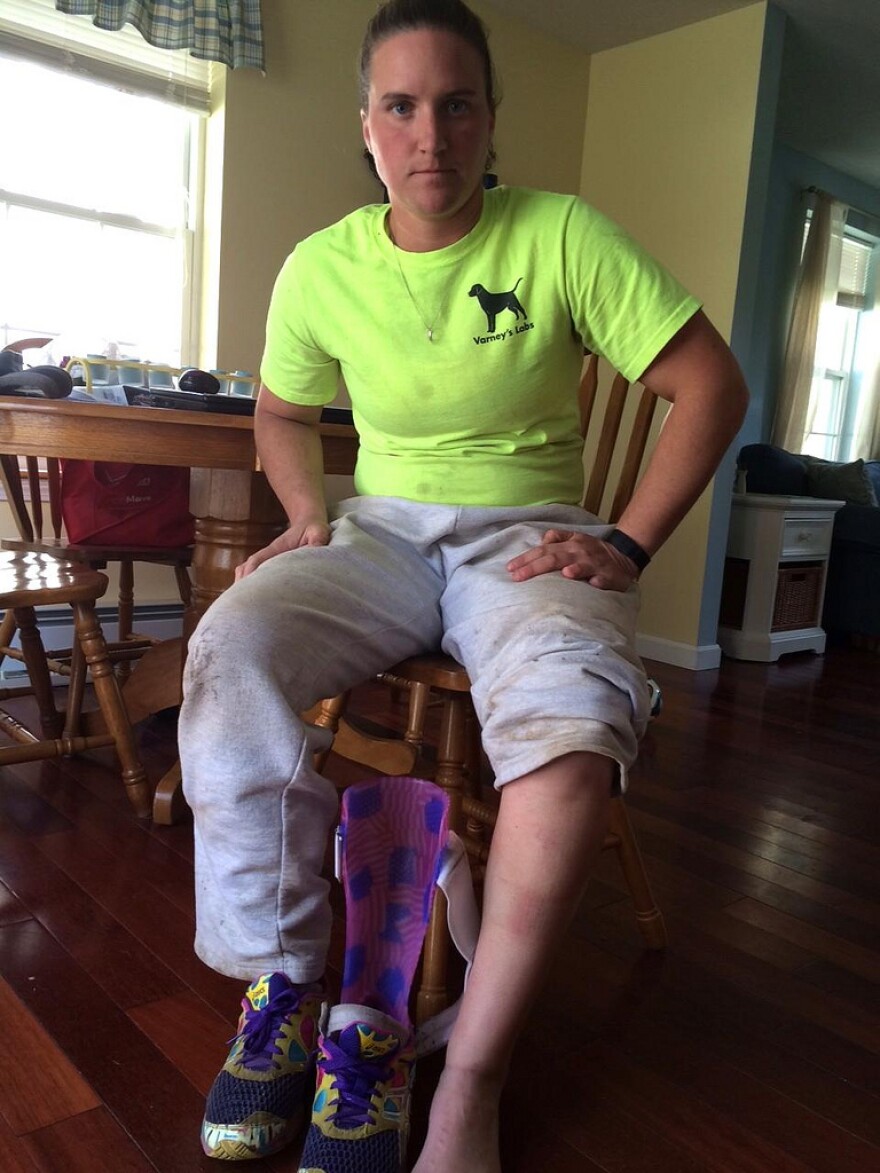LEWISTON, Maine - Christy Gardner has a tendency to push limits. In high school in Auburn, she played two sports per season. In the military, she chose police work over nursing because of the action. And when a spinal cord injury during her service damaged her lower legs in 2006, Gardner proceeded to wear out eight pairs of braces while fighting off life in a wheelchair.
But Gardner's legs are a constant source of pain and problems, so now she's pushing the limits even further. Gardner is electing to have her lower legs amputated. Most days, Christy Gardner keeps active volunteering at dog breeder Varney's Lab in Turner.
"Puppy puppy puppies! Come on guys! Come here! Look what I've got. Come here! Come eat." Gardner feeds the dogs, changes their water, and sweeps the kennel. She manages the rosters and shot records. "I love it because I really spend half the day playing with puppies, and half the day getting a work-out," she says.
Gardner wishes she could lug the 50-pound bags of food, or move the kennel fencing. But she can't feel or move her ankles. Braces keep them locked at 90 degrees, and that allows her to walk. But the braces take a toll on her legs.

"I wake up in the morning, and they're swollen and misshapen - welts, bruises, blisters from the day before. Eventually, once I cram them into my braces, the swelling starts to go down. They'll fit a little better, I'll tighten the straps throughout the day, the more I walk and move and all that. By afternoon, they start to swell up again from beating up on them all day."
In 2006, Gardner was injured in a line of duty incident while assigned as a military police officer. The circumstances of her injury are confidential, but the effects are not. "I suffered 2 skull fractures - one to the front, and one to the side of my skull," she says. "And somewhere in the Medevac process, they injured my spinal cord."
Gardner suffered brain damage and memory loss. She had to learn to speak and write again. Bookcases of photo albums help her remember people from her past. "I would say that was the worst part, or the most frustrating part."
She developed seizures, and had to wear a helmet for six years to protect herself from falls. When she got the initial prognosis for her future from doctors, it was bleak. "They went through, like, a three-page list of things I would never do again. I wasn't supposed to be able to swim, bike, live alone, no bathing alone. So many things the average person takes for granted I'd never be able to do again. I'd never drive again."
Doctors told Gardner she was 100 percent disabled and severely handicapped. "You know, obviously after a while of absorbing it, it was like no, I'm going to prove them wrong. There's still stuff I can do, and I'm going to do everything I can each day."
Gardner spent five years in rehabilitation. She got a dog, Moxie, who's trained in seizure alert and response. And ultimately, Gardner was able to move into her own house in Lewiston. She joined three different sled hockey teams, including a national vets team. "We have this running joke that on the entire roster there are six legs, and I've got two of them."
Gardner was named the national Disabled Hockey Athlete of the Year in 2012. But it was while playing sled hockey she noticed something. "All of these guys are amputees and can do so much more than I can. Some play lacrosse, some play stand up hockey on prosthetics. There's so much they can achieve, and when I see them doing stairs or hills or walking around like it's no big deal, I want to be able to do that. Why can't I get that quality of life too?"
The braces Gardner uses are painful, and the numbness in her ankles is potentially dangerous. Last summer a bee sting on her ankle landed her in the hospital because she couldn't feel it and only noticed a problem when she had an allergic reaction. "It's like, why do I have to risk stupid stuff like that to keep my legs that don't work?"
The solution, Gardner decided, was elective amputation. And she got initial support from Veterans Affairs. But when she tried to schedule the amputation with a surgeon at Walter Reed, "He said, 'I changed my mind. I can't, in good conscience, take a girl's legs. You're too pretty to lose your legs.' I was like, you've got to be kidding me. What kind of a reason is that? He had told me I'd be able to run in six months. And now you're telling me - he said, 'Be thankful you're not a quad and stuck with the
wheelchair.' "
An attempt at Togus had a similar result. Gardner says hospital administration rejected the surgery because it wasn't medically necessary. "So many of them look at it as a failure to save my legs, rather than a success at preserving my quality of life."
As Gardner's quest for elective amputation got media attention, she ultimately connected with a surgeon in California who agreed to amputate her legs below the knees. She'll do one leg at a time, and the first amputation is Wednesday.
Between surgery, travel, and expenses, it's going to cost her $14,000 per leg. Gardner says she's nervous. There are no guarantees on the outcome of her surgery. But not amputating feels like giving up. She wants to run again, and claim the life that she wants.



